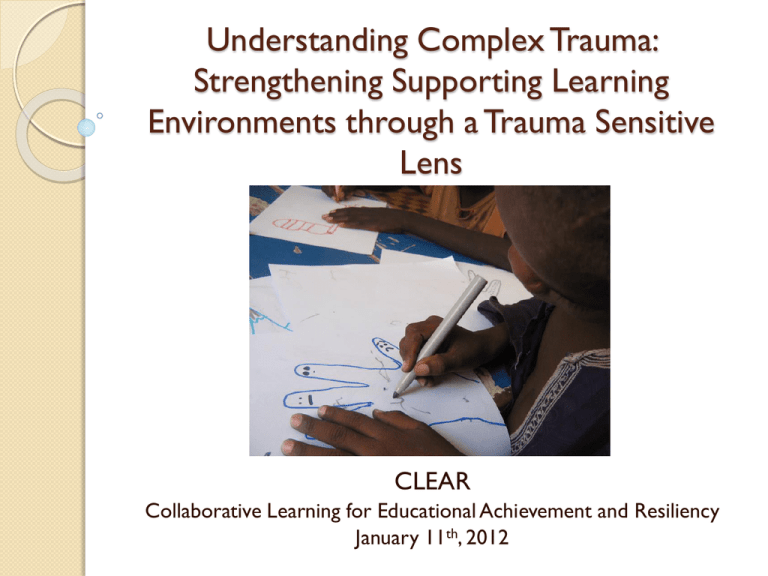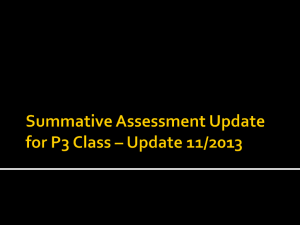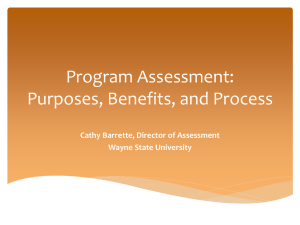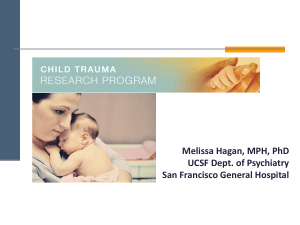Complex Trauma Training, Natalie Turner, 01.11.12
advertisement

Understanding Complex Trauma: Strengthening Supporting Learning Environments through a Trauma Sensitive Lens CLEAR Collaborative Learning for Educational Achievement and Resiliency January 11th, 2012 Complex Trauma The exposure to continuous trauma in childhood Both the being exposed to and having to adjust to this constant stress Begins early in life Occurs during most important time of development Children must be ready to react to the environment which takes energy away from healthy development Unpredictable Chronic Often occurs in episodes Copyright 2011 WSU Area Health Education Center Trauma As A Fact Of Life In one large study, 90% of respondents reported at least one lifetime traumatic event with the average number of 4.8 traumatic events in their lives (Breslau et al., 1999) Reports of adverse events in childhood predict risk of ◦ ◦ ◦ ◦ Lifetime physical health problems Mental health problems Health risk behaviors Subsequent intimate partner victimization Remember, the outcomes of trauma are not written in stone. Resilience, healthy relationship, and intervention can increase a child’s chance of success significantly Copyright 2011 WSU Area Health Education Center Copyright 2011 WSU Area Health Education Center “Children are like wet cement. Whatever falls on them makes an impression." – Hiam Ginott Copyright 2011 WSU Area Health Education Center 4 universal brain principles Our brains are designed to benefit from rich and supportive intimate social relationships. 2. Brain function must occur in a certain order. We feel and then we think. 3. Brain systems change with use throughout life. 4. Persistent stress is toxic to the brain. 1. ◦ What we don’t use as our brain is developing, we lose. Copyright 2011 WSU Area Health Education Center The brain cannot mature when it must respond to persistent threat • The brain must focus on survival rather than normal development • Can lead to delays in language and reasoning • Can lead to difficulty with learning because of always looking for danger • Trouble connecting reason with feelings • Many of the “human” brain functions like reason and impulse control get lost because these brain functions are “use it or lose it” Copyright 2011 WSU Area Health Education Center Threat Appraisal and Detection in Traumatized Children Copyright 2011 WSU Area Health Education Center Implications Of Trauma On Biological Threat Response System If we are using our trauma lens, we see that behavior is biological because it is filling a need. All behavior is functional. This means that when we look at the behavior in a child or adult, blame has no place. Understanding the biological risks points to some of the actions we can take as caring adults Copyright 2011 WSU Area Health Education Center Labels we often give traumaaffected kids Lazy Manipulative Antisocial Defiant Rebellious Uninterested Oppositional Liar ADHD Uncaring Others? Copyright 2011 WSU Area Health Education Center Overall Trauma Impact on Development Difficulty understanding what they Negative self-concept feel and how to cope with it Blame themselves for not Difficulty expressing what they feel succeeding Difficulty understanding the link between behavior, feelings, and experience Difficulty reading social cues Overly rigid or too diffuse boundaries Difficulty maintaining comfortable arousal Lack of trust or over-dependent on others Feel like they can’t impact their world Difficulty sustaining attention and concentration Difficulty planning, problem-solving, And more organizing information, and delaying response to stimuli. Believe they are not capable or competent Copyright 2011 WSU Area Health Education Center Implementation Science and Innovation Success Odds for Academic and Health Problems with Increasing ACEs Academic Severe Attendance Failure Problems Three or More ACEs N =248 Severe School Behavior Concerns Frequent Reported Poor Health 3 5 6 4 Two ACEs N=213 2.5 2.5 4 2.5 One ACE N=476 1.5 2 2.5 2 No Known ACEs =1,164 1.0 1.0 1.0 1.0 Copyright 2011 WSU Area Health Education Center Odds Ratios for School and Behavioral Problems with Increasing ACEs in the RTL Population Academic Failure* Poor Attendance School Behavior Behavioral Health Problems 2.0 5.3 3.1 6.5 Three ACEs N=756 1 3.0 1.5 2.0 Two ACEs N=1,141 1 2.5 1.6 1.8 One ACE N=1,612 1 1.6 1.2 1.2 No Reported ACES N=1,020 --- 1 1 1 Four or More ACES N=663 Copyright 2011 WSU Area Health Education Center How do ACEs affect student performance? ACEs and Percent Initial Attendance in Grades K-12 100% Mean Initial Percent Attendance 98% 96% 94% 92% 90% 88% 86% 84% 82% 80% Percent Initial Attendance K-12 No Reported ACEs N=578 91% One ACE N=800 90% Two ACEs N=537 88% Three ACEs N=409 88% Four or More ACEs N=383 85% Copyright 2011 WSU Area Health Education Center The ARC Model Trauma Experience Integration Competency Executive Functions Self Dev’t & Identity Dev’tal Tasks Affect Identification Caregiver Affect Mgmt. Attunement Modulation SelfAffect Expression Consistent Response Routines and Rituals Blaustein & Kinniburgh, 2010; Kinniburgh & Blaustein, 2005 Regulation Attachment The 3-part model Thus forcing the child to put energy into survival rather than healthy development, leaving them with developmental deficits What a child has come to understand is dangerous Will lead to a physical and/or behavioral response that tries to fill a need and find safety Copyright 2011 WSU Area Health Education Center How do I ‘do’ ARC? Not a ‘recipe’- more of an art Changes to meet the needs of individual children Doesn’t just target an outcome, targets an understanding of “why” Evaluation of a child’s needs must be ongoing as needs may change Attachment Caregiver affect management- Keep Calm and Carry On Attunement- Accurately read another’s cues and respond appropriately Consistent Response- If you do A, I will do B Routines and rituals- Provide a predictable sequence of events Self-Regulation Affect Identification- The ability to identify an emotion and tell it apart from other emotions Modulation- The ability to maintain a comfortable, appropriate level of arousal Affect Expression- The ability to share emotional experience with others and with self in a safe and healthy way Competency Executive functions- Learning to act with thoughtfulness as opposed to reacting based solely on emotion and arousal Self Development/Identity- Coming to know the intricacies of oneself in an accepting way, especially as it pertains toward personal growth Trauma Integration- Finding ways the self is fragmented, identifying how to make a conscious choice, and processing specific events Caregiver Affect Management The main idea: Support staff in understanding, managing, and coping with their own emotional responses, so that they are better able to support the children in their class Before a caregiver can help a child manage emotional experiences, the caregiver must manage their own emotional experiences Foundational skill of the ARC model Caregiver affect management directly impacts a child’s experience of environment Blaustein, M. & Kinniburgh, K. (2010) Treating Traumatic Stress in Children and Adolescents Attunement The main idea: Support staff in learning to accurately and empathically understand and respond to children’s actions, communications, needs, and feelings Attunement is the capacity to accurately read the emotional, cognitive, behavioral, and physiological cues of another that are both verbal and non-verbal and respond appropriately Children who have experienced complex trauma often lack the skills to easily identify and communicate what they are feeling and cope with difficult emotions How do we interpret the meaning behind behavior? Look pass the top of the iceberg and respond to what is underneath Identifying student’s triggers and danger response Reflective listening skills Blaustein, M. & Kinniburgh, K. (2010) Treating Traumatic Stress in Children and Adolescents Consistent Caregiver Response The main idea: Support staff in building predictable, safe, and appropriate responses to children’s behavior in a manner that acknowledges and is sensitive to the role of past experiences in current behavior Predictability builds sense of safety in environment Limit setting as potential trigger for feeling powerless Predictability over time allows children to relax vigilance and control and put their energy into normal development Blaustein, M. & Kinniburgh, K. (2010) Treating Traumatic Stress in Children and Adolescents Routines and Rituals The main idea: Support staff in building routine and rhythm into the daily lives of children and families Again! Predictability builds sense of safety Routine vs. ritual Target building routine particularly around areas of vulnerability Transitions can be especially difficult Blaustein, M. & Kinniburgh, K. (2010) Treating Traumatic Stress in Children and Adolescents Affect Identification The main idea: Work with Children may miscue others as a children to build an awareness of way of protecting themselves internal experience, the ability to from emotions that feel unsafe discriminate and name emotional states, and an understanding of why these states originate Children who have experienced poor caretaking and poor emotional support may have never developed healthy ways to identify what they are feeling Limited skill set may be easily overwhelmed by state of arousal Blaustein, M. & Kinniburgh, K. (2010) Treating Traumatic Stress in Children and Adolescents Modulation ◦ Failure to regulate The main idea: Work with children to develop safe and ◦ Over-regulating/constricting effective strategies to manage Children who can’t modulate and regulate physiological and may compensate by emotional experience, in ◦ Over-controlling or shutting off service of maintaining a emotional experience comfortable state of arousal “Children who experience unresponsive, inconsistent, or abusive caretaking may fail to develop healthy ageappropriate skills and instead must rely on primitive regulation strategies.” Young children rely on their caregivers to modulate for them, thus helping develop these skills These strategies may include: ◦ Manage emotional experience with physical stimulation ◦ Turning to external methods to alter or control physiological experience. Blaustein, M. & Kinniburgh, K. (2010) Treating Traumatic Stress in Children and Adolescents Affect Expression The main idea: Help children build the skills and tolerance for effectively sharing emotional experience with others. The ability to effectively communicate feeling is directly related to the ability to build relationship and master important developmental tasks. When children’s emotional environment is rejecting, angry, or indifferent, they often learn their emotions are shameful and should be kept hidden. Hiding emotions may help children who have experienced complex trauma feel more in control and able to navigate feeling unsafe. Trauma may impact affect expression in children by: ◦ Failure to share emotions ◦ Emotions emerging in unhealthy ways ◦ Communicating emotions ineffectively ◦ Over-communication Strengthen Executive Functions The main idea: Work with children to act, instead of react, by using higherorder cognitive processes to solve problems and make active choices in the service of reaching identified goals Include impulse control, purposeful decisions, considering consequences, understanding outcomes, problemsolving, etc. Executive functions are sacrificed in developing individuals who are trauma affected. Instead, the danger response is activated The development of executive functions can: ◦ Serve as a way to modulate intense Blaustein, M. & Kinniburgh, K. (2010) Treating Traumatic Stress in Children and Adolescents arousal ◦ Provide a sense of control and ability to impact the world ◦ Bring conscious thought to actions ◦ Increase likelihood of developing high resilience Self-Development and Identity ◦ understanding of preferences and values The main idea: Support children in exploring and building an ◦ identifying personal traits understanding of self and personal ◦ is an on-going process throughout life identity, including identification of State-dependent self-concepts may unique and positive qualities, develop, where children feel their development of a sense of coherence identity changes with their experience across time, and support in the in the moment capacity to imagine and work toward Focusing on the immediate moment a range of future possibilities limits a child’s perception of self to “Children who are routinely rejected, what is rather than what could be harmed, or ignored internalize an understanding of self as unlovable, unworthy, helpless, or damaged.” Self development includes: ◦ understanding self as separate from others Blaustein, M. & Kinniburgh, K. (2010) Treating Traumatic Stress in Children and Adolescents Trauma Experience Integration The main idea: Work with children to actively explore, process, and integrate historical experiences into a coherent and comprehensive understanding of self in order to enhance their capacity to effectively engage in present life The ultimate goal for trauma affected individuals is to “build [capacity] to harness internal and external resources in service of effective and fulfilling navigation of their life, across domains of functioning, as they define and meet self-identified personal goals.” 2 ways: ◦ Integration of themes of fragments of self and the associated early experience ◦ Process specific events Blaustein, M. & Kinniburgh, K. (2010) Treating Traumatic Stress in Children and Adolescents “The world breaks everyone and afterwards many are strong at the broken places.” ~ Ernest Hemingway Copyright 2011 WSU Area Health Education Center Some Do’s and Don’ts of Having a Trauma Sensitive Lens Do ◦ Notice your tone, body language, and word choice ◦ Paraphrase before you correct ◦ Be consistent ◦ Remember that behavior comes from need ◦ Practice calming yourself before you respond ◦ Respond to every child as if there’s a possibility they’ve experienced trauma ◦ Praise efforts not character ◦ Remember that every interaction you have with a child tells them something, either positive or negative, about who they are Don’t ◦ Panic ◦ Yell, grab, or intimidate ◦ Feel like you have to ‘fix’ a child’s trauma if they share with you ◦ Sum up the child’s character with a negative label ◦ Feel like you have to do it perfectly- being trauma sensitive takes practice and patience ◦ Blame, either the parents or the kid- Everyone is doing the best they can to cope all the time ◦ Mistake “Won’t” for “Can’t” ◦ Think you have to like every kid Copyright 2011 WSU Area Health Education Center What traumatized kids need… Predictability ◦ Routines ◦ Consistent response from their caregiver Understanding ◦ Caregiver works to learn child’s triggers and sense them when they’re going to happen Emotional coaching ◦ Help understanding when they’re feeling something ◦ Help with calming their body down or energizing it ◦ Help expressing feelings in a safe way Patience Expectations Praise that focuses on their specific action rather than character A chance to talk about what they’ve experienced A safe haven and a secure base Copyright 2011 WSU Area Health Education Center Things to ponder… How are you already using a trauma sensitive lens and be curious about each of your families in your professional role? What are the costs of having a trauma sensitive lens in your role? What are the benefits of having a trauma sensitive lens in your role? What are other things you’d like to try that would support being trauma sensitive in your organization? Copyright 2011 WSU Area Health Education Center If you’d like more information www.nctsn.org http://www.traumacenter.org/research/asc ot.php http://extension.wsu.edu/ahec/trauma/Pag es/ComplexTrauma.aspx “Brain Rules” by John Medina “Helping Traumatized Children Learn” report and policy agenda by the Massachusetts Advocates for Children Copyright 2011 WSU Area Health Education Center








